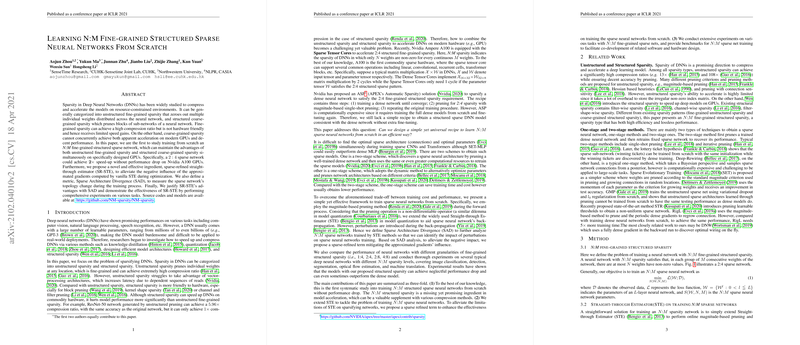Learning N:M Fine-grained Structured Sparse Neural Networks From Scratch
The paper "Learning N:M Fine-grained Structured Sparse Neural Networks From Scratch" addresses the pressing challenge of efficiently training deep neural networks (DNNs) in resource-constrained environments. The authors propose a novel approach to construct neural networks with N:M fine-grained structured sparsity, defined as networks in which only N weights are non-zero for every M consecutive weights. This methodology aims to strike a balance between the compression benefits of unstructured fine-grained sparsity and the performance efficiency of structured coarse-grained sparsity, particularly on custom hardware such as Nvidia A100 GPUs.
Context and Challenges
Deep neural networks, while powerful, often require immense computational resources due to their vast number of parameters. This poses challenges for deploying such models in real-world applications where computational resources are limited. Sparsity techniques offer a solution by reducing the number of active parameters, but they come with trade-offs. Unstructured sparsity allows high compression but lacks hardware optimization, leading to insignificant speed-ups. In contrast, structured sparsity is more hardware-friendly but tends to degrade model performance substantially.
Approach and Methodology
This research undertakes the first in-depth exploration of training N:M structured sparse networks from scratch without significant performance degradation. By leveraging 2:4 fine-grained structured sparsity, the authors demonstrate up to a 2x speed-up on Nvidia A100 GPUs without a drop in accuracy.
To facilitate efficient training, the paper introduces the Sparse-refined Straight-through Estimator (SR-STE). This modification of the traditional STE compensates for the negative impact of approximate gradients on network training dynamics by using a sparse-refined term. This term helps ensure stability in the learned sparse network's topology, as quantified by the newly introduced Sparse Architecture Divergence (SAD) metric.
Strong Numerical Results
The authors conduct comprehensive experiments across various computer vision tasks (such as image classification, detection, and segmentation) and machine translation, demonstrating the efficacy of the proposed method. Notably, the sparse networks trained with their approach achieve comparable or even superior performance to their dense counterparts, depending on the granularity of sparsity (e.g., 2:4, 4:8).
Implications and Future Directions
The implications of this work are multi-faceted, impacting both theoretical and practical facets of neural network sparsity. Theoretically, it contributes to understanding the relationship between dynamic pruning, gradient estimation, and network performance. Practically, it presents a robust framework for deploying efficient DNNs on modern hardware, paving the way for more accessible deep learning applications in resource-limited environments.
As future directions, it would be valuable to explore the extension of N:M fine-grained sparsity beyond commonly used operations to others such as attention mechanisms in transformers. Furthermore, mixed or adaptive N:M sparsity could be investigated to optimize performance across varied application domains.
In summary, this work provides an important stepping stone towards efficient neural network deployment, offering insights and methodologies that are adaptable to the evolving landscape of hardware and software co-design in deep learning.
